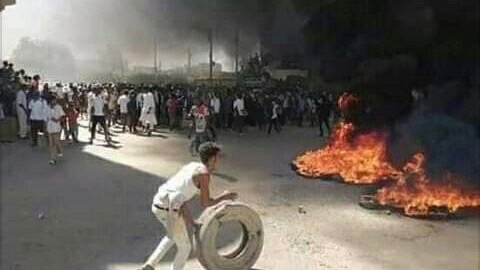Several protesters were injured and at least 77 protesters were detained in the Sudanese capital Khartoum on August 17, Monday, after police fired tear gas and attacked a protest rally. The protesters had reached the offices of cabinet ministers to submit a memorandum of demands to prime minister Abdalla Hamdok.
Called the ‘march of millions’, the rally had been organized on the first anniversary of the ratification of the Constitutional Declaration which paved the way for the formation of the transitional government in Sudan. The rally started at different assembly points in Khartoum, Khartoum North and Omdurman, and converged near the cabinet ministers’ offices.
The aim of the protest was to hand over a memorandum to the prime minister, calling on the transitional government to fulfill its mandate, as presented to it by the protest movement which had brought it to power last year after ousting long-time dictator Omar al-Bashir. Key demands included the formation of the legislative council and a solution to the financial crisis. However, the protesters were met with violence
The coordinating body of the resistance committees said in a statement that it was “shameful and unacceptable” that Hamdok “chose to hide behind the curtain” and “sent a representative to meet the masses”. When the protesters rejected this offer and demanded to see the prime minister, the police fired tear gas and used “excessive force to confront them”.
Many of the injured had to be carried to hospitals in ambulances. Lawyers affiliated to the protest movement who rushed to police stations to secure the release of protesters were also allegedly attacked by the police.
The coordinating body of the resistance committee called “on the revolutionaries.. to close streets and burn tires in response to the government’s shameful and humiliating treatment, and we also announce to the Sudanese people that the open mobilization and escalation will continue in the coming days in various forms and methods.”
It is reported that numerous clashes between the security forces and protesters occurred until late in the evening. Police continued to attack the protesters even after they had been dispersed from around the cabinet offices and were staging road blockades.
The organization of ‘Families of the martyrs of the glorious Sudanese revolution 2018’ also condemned the police action. It said in a statement that the “blood of martyrs and wounded”, who had sacrificed in the struggle against the dictatorship, was still fresh in the memory of the Sudanese people.
Key demands
One of the key demands articulated in the memorandum is the immediate formation of the legislative council. This body was to be formed by November 2019. This body will be crucial to counter the influence of the military in the other two bodies already set up as part of the transitional government – the Sovereignty Council and the cabinet. The Sudanese military was deeply entrenched in the former regime, and has been accused of gross human rights violations and crimes.
The Sovereignty Council, the highest body within the transitional government, has equal representation from the military and the civil society, but is headed by military generals. The other body, the cabinet or the council of ministers, has the ministers of defense and internal security appointed by the military.
Another crucial demand of the protesters is to bring the finances of the armed forces under the control of the finance ministry. Currently, the ministry has no control over the massive annual budgets allotted to the armed forces.
Protesters have also called for holding a conference to chart a way forward to resolve the severe economic crisis, which the transitional government has failed to solve. They are also demanding concrete measures to speed up the peace process with the armed rebel groups in the country, including the dissolution of the Rapid Support Forces (RSF).
The RSF is a militia cultivated by the army under Bashir’s rule, which was allegedly instrumental in committing the genocide in Sudan. It is headed by the current vice-president of the Sovereignty Council, General Homamad Hamdan Dagalo, better known as Hemeti, and continues to sow terror in the largely non-Arab communities in the civil-war affected regions.
Monday’s protest rally was organized by the resistance committees which were the backbone of the coordinated uprising that led to Bashir’s removal in December 2018. The committees had organized at the neighborhood level to build a mass protest movement which continued even after his ouster, holding out against the military junta which had assumed power. The junta was finally forced to make way for the formation of a civilian-majority government after a massacre at the hands of the RSF.
The government that was eventually formed was the result of a compromise between the junta and the Declaration of Freedom and Change forces (DFCF) – a coalition of political parties which came to represent the protest movement.
Abdalla Hamdok was chosen for the position of prime minister by the DFCF. As the protest movement had installed him in power, protesters on Monday demanded that he personally receive their memorandum of demands.





